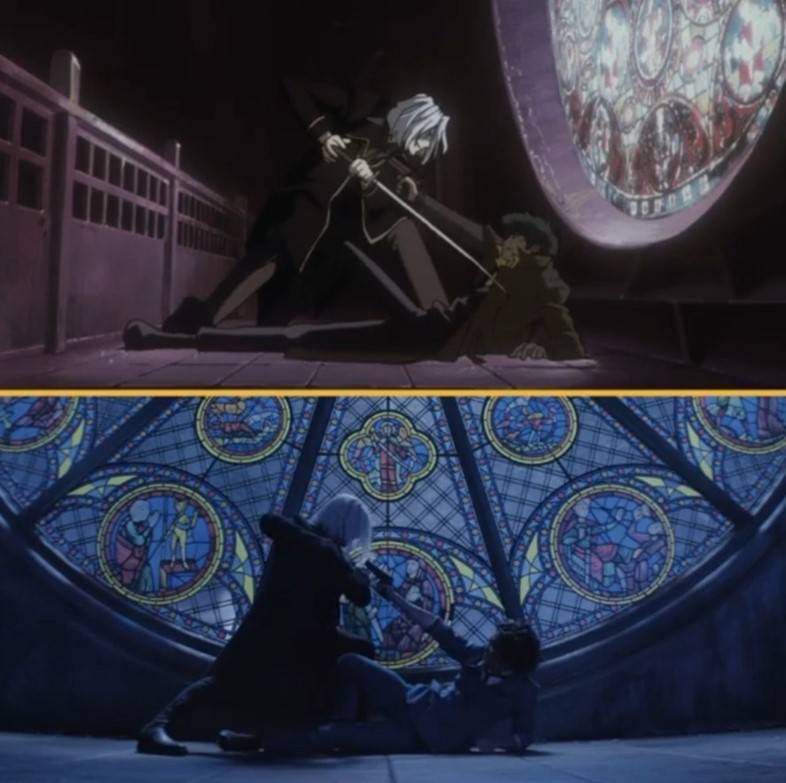Series Review: Cowboy Bebop Live Action
Inhalt/Content
Anyone who knows me knows that I’m a big Cowboy Bebop fan. Not only do I think it’s the best anime of all time, I watch all 26 episodes of the series every year and own the complete Bluray box, the manga and even the parlor game.
Over the decades there have been rumors that there will be a live action adaptation of this anime, which is also popular in the West. But often it just stayed with the rumors like when it was said that Keanu Reeves should play Spike Spiegel. That was back in the late 2000s. The project was never really tackled because it would have been too complex and you could never have raised enough money for it. It would have taken at least as much money to make it look good as other sci-fi franchises like Star Wars or Star Trek. The only series that was filmed in the early 2000s that has a lot of parallels to Cowboy Bebop is “Firefly”. Unfortunately, it was canceled after one season and also had its small technical problems. Only a later film, which roughly brought the story to an end, was able to show how good the series could have looked.
Almost 20 years after the anime, Netflix announced in 2018 that they would be producing a live action series based on Cowboy Bebop. The joy of this news was slightly dampened on my part. On the one hand, I am pleased that a live action production is finally taking place and that Netflix, as a large company, can certainly let enough money flow in, on the other hand, Netflix has proven often enough in recent years how good they are at anime franchises Live-action films can hit the wall. The new “Rurouni Kenshin” movies are very good adaptations, while “Fullmetal Alchemist”, “Bleach” and especially “Death Note” are more like failures. They’re basically not as bad as “Dragonball Evolution” or “The Legend of Aang”, but they gave away a lot of potential.
After it was rather quiet about the live action adaptation for around 3 years (of course also due to Corona), the first trailers came in 2021 and the whole series followed in November. In the following I would like to give my opinion on the aspects of style (which is very important in Cowboy Bebop!) and story. Finally, a summarized conclusion follows.
Style
Cowboy Bebop is an anime series that relies heavily on its style. Be it the integrated pop culture with current topics, the characteristic opening or the consistently successful soundtrack. With a new edition or continuation of the franchise, one naturally has worries that these things could be missing or even badly reinterpreted. A negative example of this would be the DVD collection of the German anime version, where you couldn’t license all the songs in the series and therefore there were funny cuts and new soundtracks in certain episodes (but luckily not in the Blu-ray release).
However, none of these concerns existed with the Netflix Live Action adaptation, because practically the entire soundtrack of the original was taken over, partly remixed or expanded here and there. This was directly emphasized by showing the opening as a trailer in September 2021. It corresponded 1:1 to the original of the anime, only with real actors. When the real series started in November, however, opinions quickly differed. What was the issue?
Although the style was mostly well done and the actors really shined in their roles, it doesn’t always work as well as in the anime template. Many scenes seem too “colorful” and not quite as “dreary” or “run down” as in the anime template. The series was mostly filmed in the port city of Auckland, New Zealand, which is fitting in many episodes, but doesn’t quite reflect the variety of planets and moons of the original. Along with this is the lack of flight and space scenes. These always represented small highlights in anime, while they were often missing in live action. In comparable anime episodes, such as “Save the water rats” (“Gateway Shuffle”), where the finale took place in space at the gates, the live action version was rewritten without flying.
On the other hand, the slapstick interludes of the characters themselves were well captured. Spike often just eats his instant noodles, Jet gets upset about the upkeep of the bebop, and Faye is cheeky and mostly just does her own thing. Especially the disputes between the main characters were always staged well. Ein, as the crew’s dog and mascot, may have had a little less screen time on this one, but the “bloopers” in the extra scenes also show that corgis weren’t easy to work with.
Another important element from the original artwork is the battle scenes. Spike is known for practicing “Jeet Kune Do” (Bruce Lee’s martial art style), while Jet and Faye prefer dirty street fighting. Efforts have already been made to include these elements in the live action series, but unfortunately you can tell from the rather slow reactions and the many cuts that the actors aren’t masters of martial arts. However, this was mostly made up for by the fun and natural behavior of the characters in various scenes, which is why the cast of the actors is still quite successful.

Furthermore, many scenes from the anime could be transferred very well into the real world. For example, the fight between Vicious and Spike in the church was recreated in the same atmosphere, or the character Mad Pierrot was given a dark, crazy portrayal, which was also not easy to realize from the anime and was done very well here.
Plot
The storyline differs from the anime in three fundamental ways: 1) it covers only half of the anime series (so far), 2) the focus is much more on the Syndicate, and 3) the episodes are dealt with in a different order. In the following paragraphs I would like to briefly discuss the advantages and disadvantages of these aspects.
In itself, it’s not really a problem that the order of the episodes has been changed slightly compared to the anime. While the first few episodes stay relatively close to the anime, e.g. how Faye and Ein join the crew, later episodes often cover content from the later part of the series. But since the original was already very episodic and only rarely showed a storyline that runs through the background, it’s not too bad that you took liberties here.
Quite different and controversial is the much stronger focus on the syndicate. Practically 1/3 or almost half of each episode is about Vicious and Julia. While Vicious only got an episode here and there in the anime and seemed quite opaque in his actions and character, Julia only appeared in the last two episodes in the anime. In the live action series, the tables have been turned and both have been given a lot of prominence, which also means that Spike’s past is addressed in a much more thorough way. This is quite interesting because many of Spike’s facts have previously only been guessed at, while this time they are properly explained. Unfortunately, Vicious loses his certain mysterious and cool magic because you see him far too often and almost every motive of his can be questioned. This doesn’t change until the end of the first season after 10 episodes, but still brings a twist at the end that is clearly different from the anime and makes the story even more interesting for a second season. Nevertheless, the anime shone with its varied bounty hunts, which unfortunately were often shortened due to the focus on the syndicate. As already reported under the aspect “Style”, some flight scenes were therefore also deleted.
A third point, which is not tragic in itself, but which probably also led to an early abandonment of the series for fans, is the absence of the hacker child Ed. The live action series has only 10 episodes and only reflects about 13 episodes, i.e. half, of the anime. Since Edward Wong Hau Pepelu Tivruski IV (Ed for short) only appears in the anime from episode 9, it was decided to only include him in the live action series at the very end (besides a few cameo appearances). But since this is a fan favorite, that probably wasn’t the best strategy. For a second season, Ed would have been the first important main character, but unfortunately in this first season he was not “successful”.

Conclusion
The Cowboy Bebop Live Action Series lives up to the original in many ways. This is reflected in the music, in great and exciting scenes and especially in the actors, who put a lot of effort and fun into the series. Unfortunately, the iconic flight scenes and space stories are missing here and there, making way for a reinterpreted syndicate story that only gets interesting towards the end. A second season could be a lot better, especially if fan-favorite Ed joins the crew, but unfortunately (as of now) the series was canceled by Netflix due to low ratings and there will probably never be a second season.
My review: ★★★★☆
- Style has mostly been well adopted or evolved
- Actors fit roles and play them with passion
- interesting twists and changes that make the story unique as a reinterpretation
- painstakingly told syndicate story
- many missing flight scenes on planets or in space
- sometimes scenery or choreography that needs improvement
